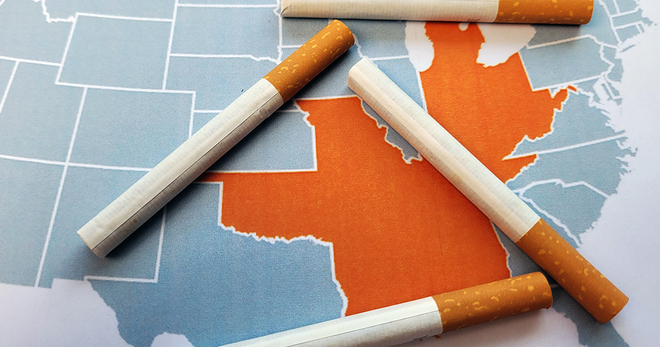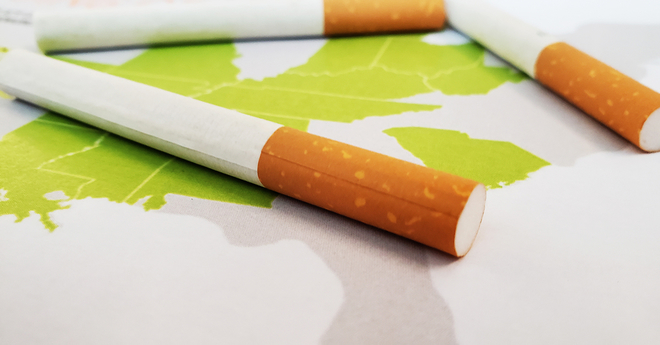Tobacco use in Washington 2023
Cigarette use: Washington*
Smoking rate in Washington
- In 2022, 10.0% of adults smoked. Nationally, adult smoking prevalence was 14.0%.1
- In 2021, 4% of 12th graders in Washington smoked cigarettes on at least one day in the past 30 days. 2,3
Other tobacco product use: Washington*
Vaping rates in Washington
- In 22, 7.1% of adults in Washington used e-cigarettes. Nationally, adult e-cigarette use prevalence was 7.7%.1
- In 2022, 2.9% of adults in Washington used smokeless tobacco every day or some days. Nationally, adult smokeless tobacco use prevalence was 3.4%.1
- In 2021, approximately 15% of 12th graders in Washington used vapor products on at least one day in the past 30 days.2
- In 2021, approximately 1% of 12th graders used chewing tobacco, snuff or dip on at least one day in the past 30 days.2
Economics of tobacco use and tobacco control
Cigarette tax in Washington
- Washington received $510 million (estimated) in revenue from tobacco settlement payments and taxes in fiscal year 2023.4
- Of this, the state allocated $6.6 million in state funds to tobacco prevention in fiscal year 2023, 10.3% of the Centers for Disease Control and Prevention’s annual spending target.4
- Smoking-caused health care costs: $3.26 billion per year.4
- Smoking-caused losses in productivity: $6.1 billion per year.5
Washington tobacco laws
Washington tobacco laws
Tobacco taxes
- Washington is ranked 11th in the U.S. for its cigarette tax of $3.025 per pack (enacted May 2010), compared to the national average of $1.93. (New York has the highest tax at $5.35 and Missouri has the lowest at 17 cents.)6-8
- Little cigars are taxed at 15.125 cents per cigar. All other cigars are taxed at 95% of the taxable sales price, not to exceed 65 cents per cigar.
- Moist snuff is taxed at the greater of $2.526 or 83.5% of the cigarette tax multiplied by 20 for consumer sized cans or packages that weigh 1.2 ounces or less. Cans or packages that weigh more than 1.2 ounces are taxed at a proportionate rate for each ounce or fractional part of an ounce above 1.2 ounces.
- Vapor products are taxed at 27 cents per milliliter of solution and a proportional tax at a like rate on fractional parts of a milliliter regardless of whether it contains nicotine. Containers of solution that contain greater than 5 milliliters of solution are taxed at 9 cents per milliliter and a like rate on fractional parts of a milliliter.
- All other tobacco products are taxed 95% of the taxable sales price.6,7
Clean indoor air ordinances
- Smoking is prohibited in government workplaces, private workplaces, schools, childcare facilities, restaurants, bars, casinos/gaming establishments (tribal establishments exempt), retail stores and recreational/cultural facilities.6,7
- E-cigarette use is prohibited in and on grounds of child care facilities, schools, playgrounds, school buses, elevators, within 500 feet of schools, in indoor early learning facilities, in vehicles used to transport children and outdoors on property during non-business hours in a place that would not be considered a “public place” and at least 25 feet from entrances, windows and vents. Use of e-cigarettes within public institutions of higher education is restricted through regulation. Use of electronic smoking devices in state veteran homes is prohibited (except in designated outdoor smoking areas).9
Licensing laws
- Retailers and wholesalers are required to obtain a license to sell tobacco products.6
- A license is required to sell e-cigarette products.9
Youth access laws
- In December 2019, the United States adopted a law raising the federal minimum age of sale of all tobacco products to 21, effective immediately.
- Establishments are required to post signs stating that sales to minors are prohibited and violators will be punished. The sign must also state that photo ID is required to purchase tobacco products.6
- Minors are prohibited from buying vapor products, including e-cigarettes.6
- Self-service displays of vapor products are prohibited except in retailers inaccessible to persons under 21.10
- It is prohibited to freely distribute vapor products without contemporaneous purchase of a vapor product.10
- Delivery sales of vapor products are prohibited unless the seller has a valid delivery sales license, verifies the age of the purchaser through a third-party database, and only accepts payments through a credit or debit card in the purchaser’s name.10
- It is prohibited to sell and/or advertise e-cigarettes on certain campuses of higher education.10
Local tobacco laws
- Using smokeless tobacco is prohibited at professional sports venues in King County, including Safeco Field, CenturyLink Field and KeyArena.10
Quitting statistics and benefits
Quitting smoking and vaping in Washington
- The CDC estimates 46.7% of daily adult smokers in Washington quit smoking for one or more days in 2019.11
- In 2014, the Affordable Care Act required that Medicaid programs cover all tobacco cessation medications.7**
- Washington’s state quit line invests 0.48 cents per smoker, compared to the national median of $2.37.7
- Washington does not have a private insurance mandate provision for cessation.7
Notes and references
Notes and references
*The datasets for both adults and youth prevalence were used to make direct comparisons at the state and national levels. National prevalence reported here may differ from what is reported in our national-level fact sheets. The numbers here also reflect the most recent data available. Dates of available data may differ across state fact sheets.
**The seven recommended cessation medications are NRT gum, NRT patch, NRT nasal spray, NRT inhaler, NRT lozenge, Varenicline (Chantix) and Bupropion (Zyban).
Fiore MC, et al. Treating Tobacco Use and Dependence: 2008 Update. Clinical Practice Guideline. Rockville, MD: US Department of Health and Human Services. Public Health Service: May 2008.
1. CDC, Behavioral Risk Factor Surveillance System, 2019.
2. Washington State Healthy Youth Survey, 2018.
3. CDC, Youth Risk Behavior Surveillance System, 2017.
4. Campaign for Tobacco-Free Kids, Broken Promises to Our Children: a State-by-State Look at the 1998 State Tobacco Settlement 22 Years Later FY2021, 2020.
5. Campaign for Tobacco-Free Kids, Toll of Tobacco in the United States.
6. American Lung Association, State Legislated Actions on Tobacco Issues (SLATI).
7. American Lung Association, State of Tobacco Control, 2021.
8. Campaign for Tobacco-Free Kids. State Cigarette Excise Tax Rates & Rankings. https://www.tobaccofreekids.org/assets/factsheets/0097.pdf. Accessed October 4th, 2023.
9. Public Health Law Center. U.S. E-Cigarette Regulation: 50-State Review. http://www.publichealthlawcenter.org/resources/us-e-cigarette-regulations-50-state-review. Accessed October 4th, 2023.
10. Knock Tobacco Out of the Park. https://tobaccofreebaseball.org/. Accessed October 4th, 2023. .
11. CDC, Behavioral Risk Factor Surveillance System, State Tobacco Activities Tracking and Evaluation System, 2021.
More in smoking by region
Want support quitting? Join EX Program
By clicking JOIN, you agree to the Terms, Text Message Terms and Privacy Policy.
Msg&Data rates may apply; msgs are automated.




